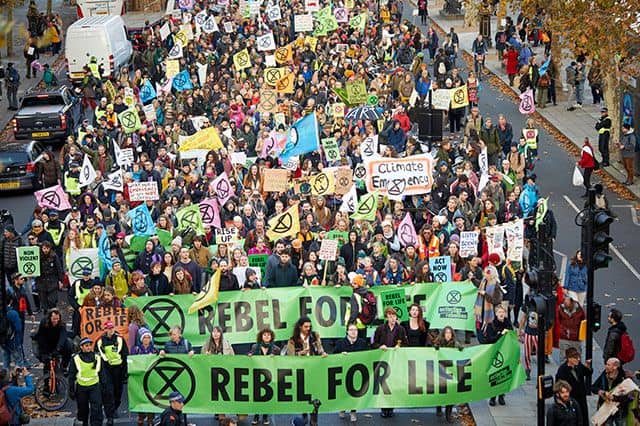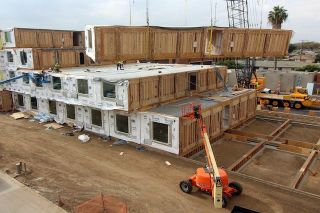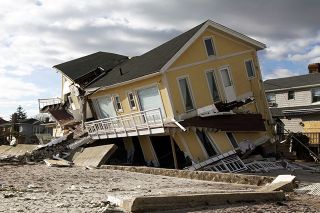
www.buildingsandcities.org/insights/commentaries/architecture-and-the-climate-emergency.html
Architecture and the Climate Emergency

Alan Short responds to the Climate Emergency and argues we must rethink our dependency on the mechanical conditioning of buildings. A city comprised of buildings with high energy demand is risky and damaging to the climate. For change to occur, the behaviours and attitudes of the supply side need to change. The main barrier is for clients and their designers to break with the status quo.
There is an irony in watching film of Extinction Rebellion activists demonstrating beneath horizons of glass office towers. These buildings are significant contributors to the problem in their profligate use of electrically driven air conditioning. Over a third of all fossil fuel energy consumed globally goes into final energy use in buildings predominantly for heating and cooling.[1] The global energy demand for space cooling has tripled over the past 30 years. It now accounts for 50% of residential peak electricity demand.[2]
If we are to effectively counter the Climate Emergency, then it is imperative to rethink our dependence on the mechanical conditioning of buildings. This involves questioning some underlying cultural ideas about air and thermal comfort. There are other ways to achieve pleasant indoor thermal conditions without using the vast amount of embodied and operational energy entailed by mechanical engineering. Making this change is not merely a technical question, but a change in the way buildings are designed, constructed and operated. It is also a matter of re-framing how we think about what it really means to be comfortable. It means rethinking a dependence on mechanical solutions.
We have become accustomed to being in wholly artificial environments in glassy office buildings (and many other building types), regardless of the climate outside. Often these buildings are completely sealed off from the natural environment outside. The 'air we breathe' is mechanically cooled, dehumidified, rehumidified, reheated and blown at us by millions of fans at colossal cost in electrical energy. This is both unnecessary and wasteful. There are more sensible ways to move air in buildings and create pleasant indoor conditions without resorting to electrical fans and expensive equipment.
How did we arrive at this situation? This bizarre practice has a distasteful provenance, the no doubt well-intended response of early Modernists to suppress warmer environments to spare the climate-oppressed, unquestionably absorbing their contemporary climate determinists' damning diagnoses of all climates except the Cool Temperate. Leading determinist Ellen Semple wrote in 1911,
'Where man has remained in the Tropics, with few exceptions he has suffered arrested development. His nursery has kept him a child…. without the respite conferred by a bracing winter season....'[3]
Ellsworth Huntington (1876-1947) further popularized climate determinism in the United States which had a dark side of climate colonialism.[4] It was argued that air conditioning could limit moral degradation. Startlingly aggressive and overtly racist advertising for domestic and work-place air-conditioning promoted these views in the interwar and immediately post-war periods.
After 1945, respectable academics simply avoided discussion of the possibility of difference based on climate, certainly in formulating public policy advice. Perhaps the universal availability of air-conditioning and cheap energy had, in their minds, negated the issue. Were there other consequences for Western architecture? Did a 'clean aesthetic' wrapping a 'clean atmosphere' suppress other promising emerging architectural propositions?[5] Hygiene and de-odourised cleanliness becameassociated with transparency, the all glass building, a phenomenon with an extraordinarily complex provenance, perhaps, as the architectural critic Reyner Banham suggested, deriving from obsessions with cleanliness.[6] In this reading the all-glass building becomes a vessel of water, a translucent sac, completely sealed from the contamination and danger of the city beyond. It has no resilience at all in any climate and can only be sustained by air conditioning. This fragility is underpinned by rising energy costs and, in turn, environmental and climate impacts.
Why have modern Western (and other) societies and their architects contracted out the responsibility for delivering 'good' air in their interior spaces?
Architects have been complicit in transferring responsibility for indoor climate to the world of mechanical and electrical engineers and subcontractors. But design can remove the need for this artificial world. A highly developed art and science of making natural environments in public buildings already exists. The use of architectural configuration had developed though the nineteenth and early twentieth centuries, advancing through the design of hospitals for natural ventilation to dilute and vent away "bad air" (e.g. airborne bacteria). Most of this design knowledge has been forgotten: removed from the architectural curriculum and replaced by the reliance on mechanical engineering.
The behaviours and attitudes of the supply side are atrophied in a persistent social practice, a dull and repetitive way of building in contractually discrete packages including the internal environment. This is maintained further by networks of risk-shedding consultants, bound by intensely defensive contractual agreements and served by industry lock-in with an immense vested interest in maintaining the status quo. But given the current projections and modelling of the changing climate, who will want to own a glass tower anywhere in thirty years? Any building with dependency on a huge energy-consuming life support machine (i.e. mechanical ventilation and air conditioning) is risky and damaging to the climate. They will be a complete liability.
All is not lost, however. It is feasible to create perfectly comfortable low-energy buildings using natural ventilation, the stack effect and building mass. Practical alternatives exist.[7] The present declarations by architects and engineers express concern about the climate and biodiversity emergency. There is a willingness to act now on several fronts, especially the commitment to significantly reduce the embodied and operational CO2 emissions. This means clients and their designers must seek alternative means to achieving thermal comfort by severing the dependence on mechanical systems.
[1] International Energy Agency, 2019. https://www.iea.org/tcep/buildings/
[2] International Energy Agency, 2019. https://www.iea.org/tcep/buildings/cooling/
[3] Ellen Semple 1911 'Influences of Geographic Environment on the Basis of Ratzel's System of Anthropo-Geography',
[4] Huntingdon, E. (1919) World-Power and Evolution. New Haven: Yale University Press.
[5] Paul Overy investigates this possibility offering striking evidence in the 1930 German Hygiene Museum, its popular exhibit on human physiology in transparent plastic, 'The Glass Man', revealing his internal organs and veins, all illuminated. Overy comments, 'The figure clearly embodied ideas about the implied relationship between transparency and hygiene and cleanliness.' Overy P. (2007) Light, Air and Openness, Modern Architecture between the Wars, Thames and Hudson Ltd., London, p.50.
[6] Banham, R. (1969) The Architecture of the Well-tempered Environment. London: The Architectural Press.
[7] Short, C.A. (2017) The Recovery of Natural Environments in Architecture: Air, Comfort and Climate. Abingdon: Routledge.
Latest Peer-Reviewed Journal Content
Net zero retrofit of the building stock [editorial]
D Godoy-Shimizu & P Steadman
Co-learning in living labs: nurturing civic agency and resilience
A Belfield
The importance of multi-roles and code-switching in living labs
H Noller & A Tarik
Researchers’ shifting roles in living labs for knowledge co-production
C-C Dobre & G Faldi
Increasing civic resilience in urban living labs: city authorities’ roles
E Alatalo, M Laine & M Kyrönviita
Co-curation as civic practice in community engagement
Z Li, M Sunikka-Blank, R Purohit & F Samuel
Preserving buildings: emission reductions from circular economy strategies in Austria
N Alaux, V Kulmer, J Vogel & A Passer
Urban living labs: relationality between institutions and local circularity
P Palo, M Adelfio, J Lundin & E Brandão
Living labs: epistemic modelling, temporariness and land value
J Clossick, T Khonsari & U Steven
Co-creating interventions to prevent mosquito-borne disease transmission in hospitals
O Sloan Wood, E Lupenza, D M Agnello, J B Knudsen, M Msellem, K L Schiøler & F Saleh
Circularity at the neighbourhood scale: co-creative living lab lessons
J Honsa, A Versele, T Van de Kerckhove & C Piccardo
Positive energy districts and energy communities: how living labs create value
E Malakhatka, O Shafqat, A Sandoff & L Thuvander
Built environment governance and professionalism: the end of laissez-faire (again)
S Foxell
Co-creating justice in housing energy transitions through energy living labs
D Ricci, C Leiwakabessy, S van Wieringen, P de Koning & T Konstantinou
HVAC characterisation of existing Canadian buildings for decarbonisation retrofit identification
J Adebisi & J J McArthur
Simulation and the building performance gap [editorial]
M Donn
Developing criteria for effective building-sector commitments in nationally determined contributions
P Graham, K McFarlane & M Taheri
Reimagining circularity: actions for optimising the use of existing buildings
R Lundgren, R Kyrö, S Toivonen & L Tähtinen
Effective interdisciplinary stakeholder engagement in net zero building design
S Vakeva-Baird, F Tahmasebi, JJ Williams & D Mumovic
Metrics for building component disassembly potential: a practical framework
H Järvelä, A Lehto, T Pirilä & M Kuittinen
The unfitness of dwellings: why spatial and conceptual boundaries matter
E Nisonen, D Milián Bernal & S Pelsmakers
Environmental variables and air quality: implications for planning and public health
H Itzhak-Ben-Shalom, T Saroglou, V Multanen, A Vanunu, A Karnieli, D Katoshevski, N Davidovitch & I A Meir
Exploring diverse drivers behind hybrid heating solutions
S Kilpeläinen, S Pelsmakers, R Castaño-Rosa & M-S Miettinen
Urban rooms and the expanded ecology of urban living labs
E Akbil & C Butterworth
Living with extreme heat: perceptions and experiences
L King & C Demski
A systemic decision-making model for energy retrofits
C Schünemann, M Dshemuchadse & S Scherbaum
Modelling site-specific outdoor temperature for buildings in urban environments
K Cebrat, J Narożny, M Baborska-Narożny & M Smektała
Understanding shading through home-use experience, measurement and modelling
M Baborska-Narożny, K Bandurski, & M Grudzińska
Building performance simulation for sensemaking in architectural pedagogy
M Bohm
Beyond the building: governance challenges in social housing retrofit
H Charles
Heat stress in social housing districts: tree cover–built form interaction
C Lopez-Ordoñez, E Garcia-Nevado, H Coch & M Morganti
An observational analysis of shade-related pedestrian activity
M Levenson, D Pearlmutter & O Aleksandrowicz
Learning to sail a building: a people-first approach to retrofit
B Bordass, R Pender, K Steele & A Graham
Market transformations: gas conversion as a blueprint for net zero retrofit
A Gillich
Resistance against zero-emission neighbourhood infrastructuring: key lessons from Norway
T Berker & R Woods
Megatrends and weak signals shaping future real estate
S Toivonen
A strategic niche management framework to scale deep energy retrofits
T H King & M Jemtrud
Generative AI: reconfiguring supervision and doctoral research
P Boyd & D Harding
Exploring interactions between shading and view using visual difference prediction
S Wasilewski & M Andersen
How urban green infrastructure contributes to carbon neutrality [briefing note]
R Hautamäki, L Kulmala, M Ariluoma & L Järvi
Implementing and operating net zero buildings in South Africa
R Terblanche, C May & J Steward
Quantifying inter-dwelling air exchanges during fan pressurisation tests
D Glew, F Thomas, D Miles-Shenton & J Parker
Western Asian and Northern African residential building stocks: archetype analysis
S Akin, A Eghbali, C Nwagwu & E Hertwich
Join Our Community

The most important part of any journal is our people – readers, authors, reviewers, editorial board members and editors. You are cordially invited to join our community by joining our mailing list. We send out occasional emails about the journal – calls for papers, special issues, events and more.
We will not share your email with third parties. Read more



Latest Commentaries
Building-Related Research: New Context, New Challenges
Raymond J. Cole (University of British Columbia) reflects on the key challenges raised in the 34 commissioned essays for Buildings & Cities 5th anniversary. Not only are key research issues identified, but the consequences of changing contexts for conducting research and tailoring its influence on society are highlighted as key areas of action.
Lessons from Disaster Recovery: Build Better Before
Mary C. Comerio (University of California, Berkeley) explains why disaster recovery must begin well before a disaster occurs. The goal is to reduce the potential for damage beforehand by making housing delivery (e.g. capabilities and the physical, technical and institutional infrastructures) both more resilient and more capable of building back after disasters.